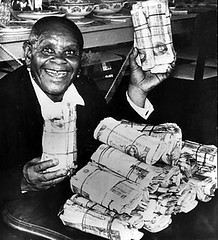Mamparas come in all shapes and sizes but the one heading the Eastern Cape education department will always be a leading candidate for the much sought after accolade which, in South Africa, is distributed with remorseless regularity, for they are legion. If I didn't know better, I'd swear the SA government had a breeding programme to churn them out.
The prizewinner is MEC for EC Education, the esteemed (or so he thinks) and pontificating Mandla Makapula, who was quoted as telling a group of South African pupils recently that they had no rights. Read it again, it isn't a misprint. Here is what he said:
'For you, rights come later in life when you are independent, finished studying and have your own place to stay and your own car. That is when you can start talking about rights.'
According to the Mail & Guardian he was allegedly referring to an Eastern Cape boy who took his father to court after he was forced to attend initiation school. This is what he added:
'I asked myself what was wrong with that boy. His father did go to the initiation school but, because of the rights now, he did not want to go there himself ... I wish he could have been my child, I would have hit him on the head with a knobkerrie and he would have gone to that initiation school crying.'
The province's education department moved swiftly to downplay Makapula's patriarchal dogmatism with an even more absurd statement from spokesman Loyiso Pulumani, who told the M&G:
'He said these things in jest, he was only trying to be humorous. He wasn't suggesting in any way that children don't have rights.'
He perhaps forgot to add that it was a perverted sense of humour, if that was the case. But I suspect, as I imagine will many readers, that it is a ridiculous excuse for authoritarianism, patriarchal dogmatism and pomposity. It's pretty much how the government runs this country and then moves quickly to dispel scandal and controversy with ludicrous and laughable spin that is so obviously rubbish.
The wildly spinning Pulumani said the provincial minister did not say these things 'in so many words'.
'There has been a misunderstanding of African idioms here. You need to try to understand the cultural differences here and the nuances in language.'
Pulumani may need to get a firm grasp of linguistics or he'll spin himself into a tizz. Unless he's aiming for the mampara of spin accolade.
Regional director of the Legal Resources Centre (LRC) told the M&G that Makapula's comments are an example of the 'state of chaos in the Eastern Cape department of education'.
So the country ploughs on under the leadership of pontificating incompetents hell bent on self-aggrandisement rather than the interests of the populace.
We have become a nation beset by a rampant and self-enriching mamparadom.
The wildly spinning Pulumani said the provincial minister did not say these things 'in so many words'.
'There has been a misunderstanding of African idioms here. You need to try to understand the cultural differences here and the nuances in language.'
Pulumani may need to get a firm grasp of linguistics or he'll spin himself into a tizz. Unless he's aiming for the mampara of spin accolade.
Regional director of the Legal Resources Centre (LRC) told the M&G that Makapula's comments are an example of the 'state of chaos in the Eastern Cape department of education'.
So the country ploughs on under the leadership of pontificating incompetents hell bent on self-aggrandisement rather than the interests of the populace.
We have become a nation beset by a rampant and self-enriching mamparadom.






